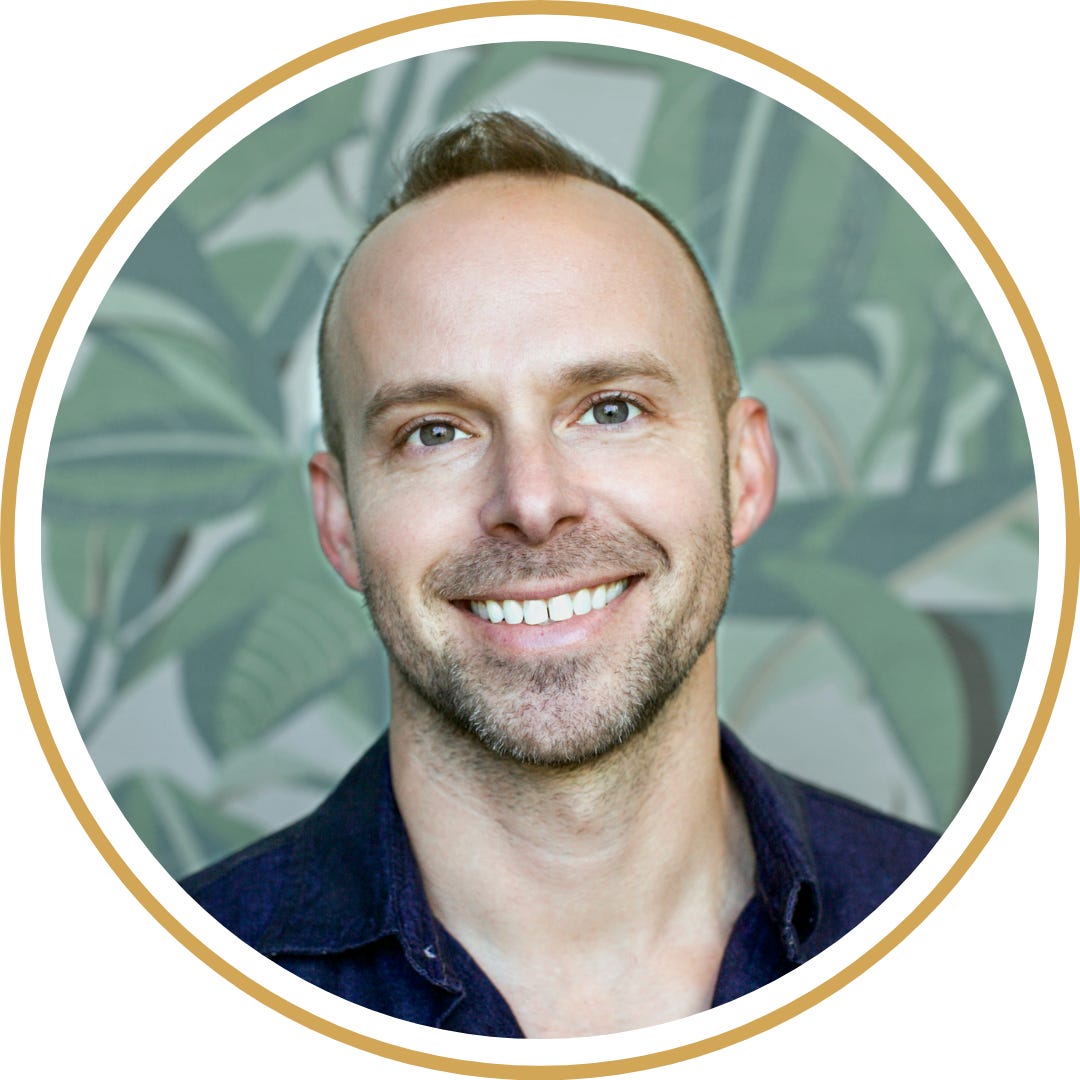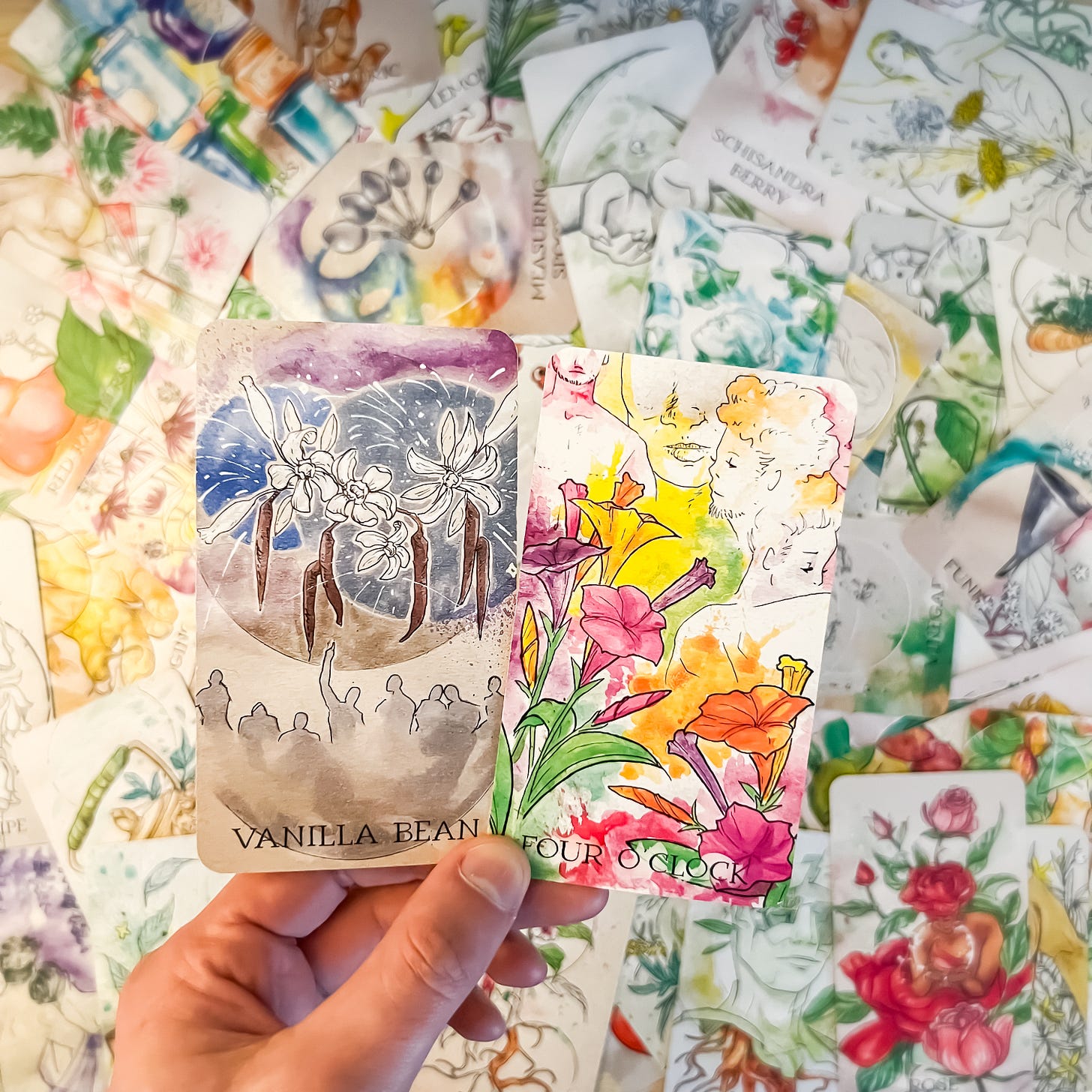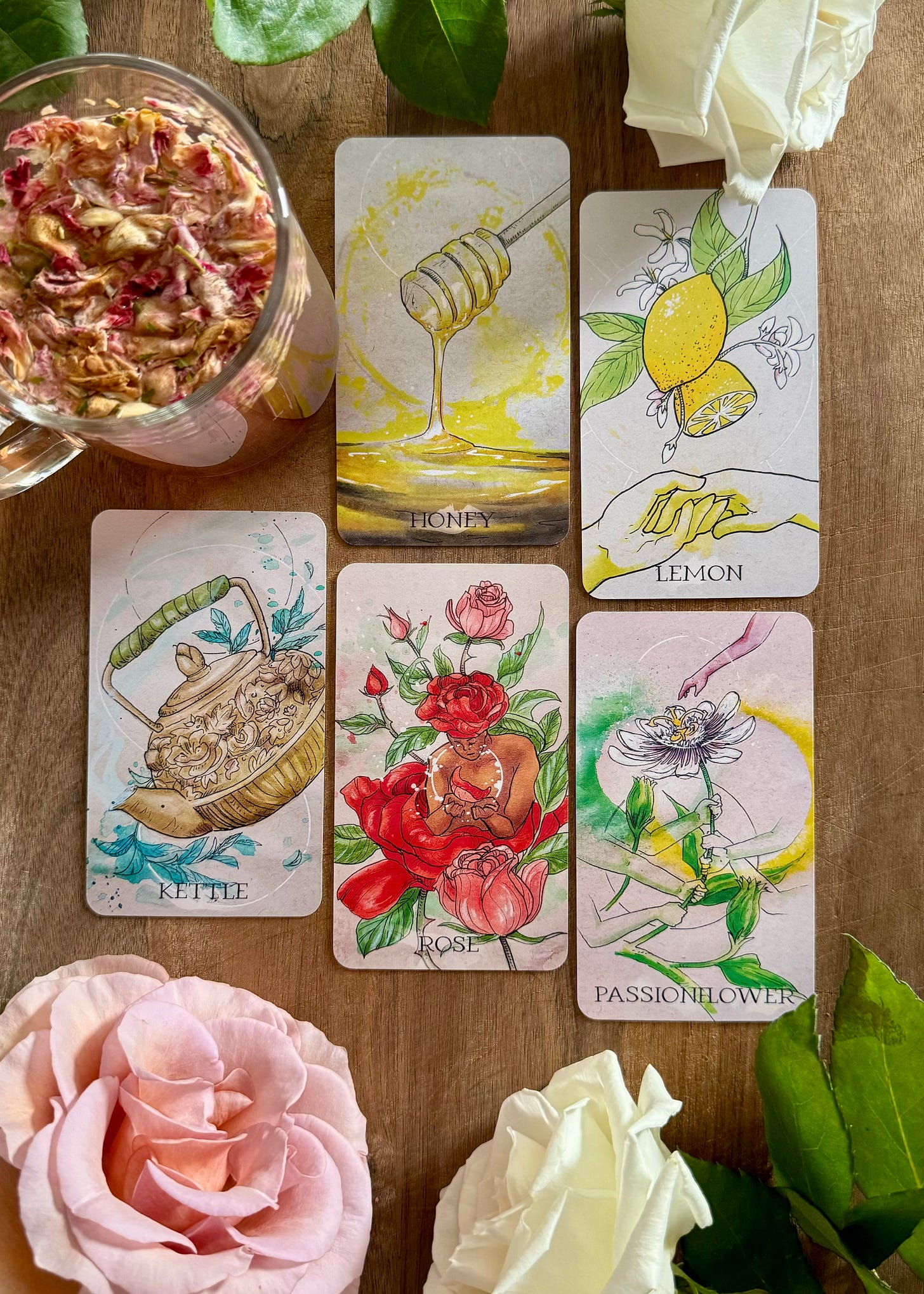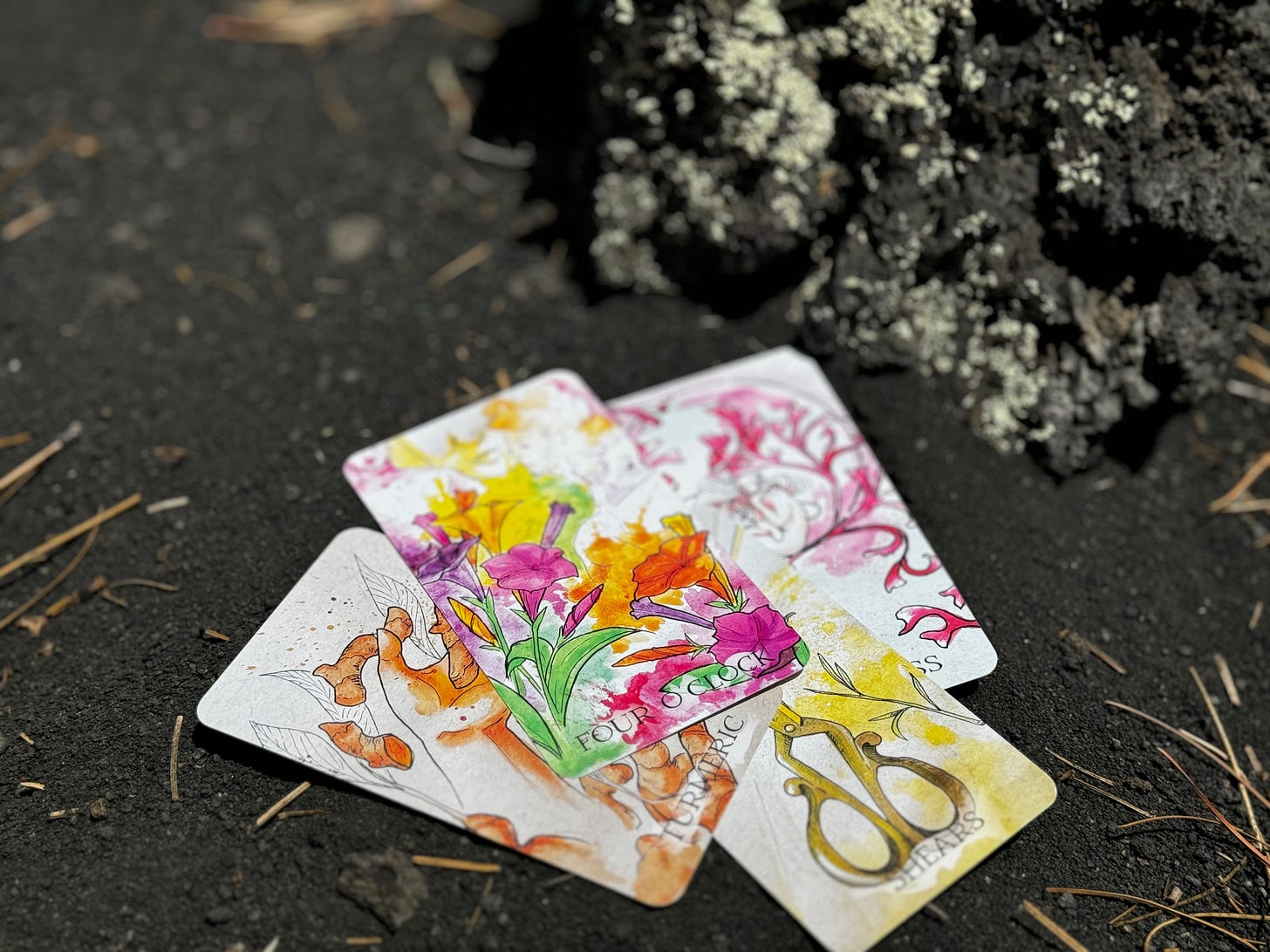Eric Maille, Michael Anthony, and Thomas Witholt, creators of the Apothecary Spirits Oracle
The Creative Council
Welcome to The Creative Council, where I interview creatives about their lives and work and the ups and downs of being a creative soul.
Today’s interview is with Eric Maille, Michael Anthony, and Thomas Witholt, who’ve created the stunning Apothecary Spirits Oracle.
The Apothecary Spirits Oracle is a collaborative deck of queer energy inspired by the healing power of herbalism. It includes 64 cards illustrated by Eric (Ink Witch Tarot, Paper Oracle, and Endless Oracle) and a guidebook full of herbalist wisdom for each (plus a few recipes!) by Michael (Small Spirits Oracle and Diviner Definitions), coordinated by Thomas (Life Line Tarot, Life Line Lenoracle, and Seaborn Kipper).
Rather than have each of them answer piecemeal, Thomas continued his role as coordinator for the deck and melded their responses, letting one collective voice capture the varied talents and experiences the three of them share with a few distinct moments to add a dash of spice.
But before dive into the interview, allow me to introduce these wonderful creators first:
Eric Maille is an independent illustrator living and working in Oklahoma. He has been working as a tarot and oracle deck creator since 2020, and the Apothecary Spirits Oracle Deck is his first collaborative deck. Other decks include Ink Witch Tarot, Paper Oracle, and Endless Oracle. Eric can be found here and under @elliamvi.
Michael Anthony is an herbalist, spiritual entomologist, deck designer, and intuitive coach & consultant. His work is dedicated to holistic healing, self-empowerment, and creating spaces where queer joy can flourish. Other decks include Diviner Definitions Oracle and Small Spirits Oracle. Michael can be found here and under @thedivinerlife.
Thomas Witholt is a divination coach, deck creator, author, and personal consultant blending mystical and mundane exercises that connect mind, body, and soul for those who simply want to live a good life. Other decks include Life Line Tarot, Life Line Lenoracle, and Seaborn Kipper. Thomas can be found here and under @hermitsmirror.
The Interview
I can’t believe we’re finally doing this! This conversation has been such a long time in the making… So how about we dive right in?
· When did you start creating? Do you remember what pulled you in?
We each started creating almost as early as we can remember, whether it was with traditional art supplies like pencil and a pad of paper drawing with friends and family or creating with elements of the world around us. As with many artistic kids, it became a primary identity. For Eric it only stopped when he went to college for art, at which point everyone was ‘the art kid’.
· When did you start pursuing your current craft for real? As in, when did you begin to take yourself seriously as a creator?
All three of us have been producing our own decks for a few years. Thomas and Michael have been creating as a supplement to support service-based work, as with our individual decks and publications or Michael’s herbalism and Thomas’s courses. But Eric, the illustrator for our deck, has an established career as a creator as far as most people would probably define it.
He writes, ‘Some part of me always wanted to be an artist in some kind of professional capacity. When it was time to decide what I was going to do after high school, I tried to consider so many other options apart from something creative, having been scared off by the common sentiment that a career in the arts isn’t practical. (That’s a sentiment I no longer agree with at all.) But there was just nothing else for me to do. I don’t have much of a talent or interest in many other things, and I remember hearing someone say, “If you can do anything other than art, then do that instead. If you can’t, then do art,” and I just thought “Yeah, I simply cannot do anything else.” I think maybe that’s the point at which I really began seeing myself as a “serious” creator.’
· How long did it take you to complete your first work?
Our experiences here varied wildly from Thomas’s 3-month Life Line Tarot to Eric’s 3-year Ink Witch Tarot. Neither was going to be a deck originally. Both decks were made of tarot art for art’s sake, so you could say the original work was done in a month for each of us, but then the definition of the work changed. But eventually it became clear for each of us that there was a deck there. The realization of whether you’re creating a product to sell or creating art for the sake of it can greatly affect the timeline.
· How long does it generally take you to complete a work?
There’s no one answer to this. It depends a lot on the style and technique used. For Thomas’s single-line decks, it’s usually a couple months for the art. And then the guidebooks take a little longer. But decks involving more complex art can take years unless you’re clear on the vision.
Eric’s Endless Oracle, where all the cards need to be able to line up into a panorama regardless of their order, took much more planning and editing to produce than his most recent deck, The True Sight Oracle, which has a simpler art style.
For a second (or later deck), a year is a good estimate once you’re clear on what you’re doing, know how to produce a deck, and have time to devote to the tasks. And then there’s production and delivery time.
· And how long did it take to finish this collaborative project?
The Apothecary Spirits Oracle took 2 ½ years from our first real meeting to sending final files to the printer. It’s an oracle deck, so there’s no inherent structure as in tarot or Lenormand; that adds time. And it’s truly a teaching tool for herbalism, so that meant we couldn’t just pick pretty plants or fun compositions that wouldn’t relate. There are certain flowers that are toxic to eat and certain aspects of the plant that aren’t as useful in herbalism as other parts, so we had to be careful about what was depicted and described in the guidebook.
All of this meant that it took Eric a fair amount of time to finish many of the illustrations. He writes, ‘Before the project, I wasn’t familiar with a lot of the plants that are featured in the deck and so the research phase of the art-making process took quite a bit of time. Some happened within a day or two, but others took a week or longer to finish.’
· What was it like to collaborate on this project?
It’s wild how much the project changed from Thomas’s original concept of a deck of silly gay flower fairies (his words) to the Apothecary Spirits Oracle that the three of us created together. We met regularly, and Eric and Michael asked Thomas good questions and offered suggestions when there weren’t great answers.
Michael had collaborated with an artist friend on the Small Spirits Oracle and Thomas would soon collaborate with Siolo Thompson on the Seaborn Kipper, but at the time he and Eric were both new to collaborative creations. And while Thomas knew he couldn’t do it alone, so was reaching out for help, Eric had some hesitation handing over reins of conceptual control. It’s a big ask for an artist!
But it worked out well, as I think users of the deck will agree. Each of us is good at what we do, but we all have created our own decks too, so we could all contribute in unique ways and understood where the other was coming from. We all learned from each other though, especially from Michael, who taught Eric and Thomas a lot about herbalism. And in addition to making a deck together, we made stronger friendships too.
· During the collaboration, what did you learn about yourself and your collaborators?
Having found success in individual projects makes it easy to want to grip the reins of a collaborative project tightly. But you can’t do that in a true collaboration. You have to let people do what they do best and trust that they want to do what they can. If they can’t, you reassess. But if everyone is doing what they love most and feels good about what they contribute, then the project can become greater than the sum of its parts. That might sound cheesy, but it’s true.
It’s also so great to be able to learn from and be inspired by each other’s work, whether it was Michael’s teaching about herbalism or Eric’s artistic adaptability in creating a style that we haven’t seen in his solo decks or Thomas’s organizational skills and project management, which have hopefully rubbed off to make the business parts of creator life less painful.
· Would you be up for another collaboration, with the same people or others?
Yes! It’s been great to work together, and hopefully we can find another project we all love as much. We have been lucky in our collaborations, but there are stories you hear that make you question whether you would want to if you could do it all alone. You have to trust the people you’re working with artistically, emotionally, financially, and ethically. So it’s worth considering whether the collaboration will offer you something new and exciting that wouldn’t be the same as you trying to create something alone.
There are trade-offs and risks. Even though it’s divided between people, collaborations require more overall work because there are more ideas and sometimes conflicting opinions or different visions. And when everyone has a distinct role, you have to hand over control or tasks that you might enjoy because it suits someone else better.
Thomas, for example, will need a little time away from collaborations if he is ever going to prioritize his own artwork again because it’s easy to fall into a non-art role when working with talented artists. But when a collaboration works, it’s honestly inspiring and creatively rejuvenating. So hopefully we find another project down the road.
· What has been your biggest ‘mistake’ thus far?
Eric’s is the most transferable and personal even if a little (in his own words) cheesy, so let’s hear his thoughts directly:
‘I’ve spent too much time doubting myself instead of making the things I want to make. Even now, with some pretty successful projects behind me, I still find myself doing it sometimes. I will avoid making something that I don’t think anyone else will like or find myself trying to defend my work even when no one is saying anything negative about it. I think a lot of artists have impostor syndrome and are insecure about what they make. I think it’s a natural feeling when you’re opening yourself up in a vulnerable way, but it’s definitely a mistake to let it get the better of you and prevent you from doing what you want.’
· What would you tell people about to make that same mistake?
Eric writes, ‘Try to make your art for yourself before anyone else. If you love it, other people probably will too. And if by some bizarre fluke they don’t, at least you’ve made something that you can enjoy and be proud of.’
· Of all the milestones you’ve reached thus far, what has been your favourite?
For Thomas, it was getting the Seaborn Kipper picked up by Llewellyn Worldwide because being with a large publishing house gives you new opportunities. There are trade-offs that don’t work for everyone, but he’s happy with them.
For Eric, finishing his first tarot deck project, the Ink Witch Tarot, back in 2020 is still his favorite milestone so far. It was a first step that really changed what his career as an artist looked like, and it’s led to so many other milestones since.
For Michael, the printing of his Diviner Definitions Oracle (second edition) in 2023 was his favorite. To him, it represented a reintroduction of self — a metamorphosis of sorts. It meant owning who he is, fully and unapologetically.
· When was the last time you celebrated a creative milestone?
When we found out the Apothecary Spirits Oracle decks were shipping to us! The moment that there’s a real, tangible, physical product created from all your effort is particularly special, so you have to celebrate it.
· What do you struggle with most as a creative person?
The blending of business and art or creativity can be challenging. There’s a struggle in turning the thing you want to do into the thing you have to do. It would be great to just make art for art’s sake, but when it’s your livelihood, as for Eric, there’s an added layer of stress and commercial consideration. And for Thomas and Michael, who work on lots of things that take creative energy but often aren’t as easily seen as ‘creative’ as illustration or painting, it can be hard to feel creative.
· Have you always had that struggle or has it changed over time?
Things often change for creators when art or writing or content creation become a significant part of your income, and that’s been true for us. The opportunity to do what you love can be well worth the anxiety and pressure that comes with tying a creative passion into the monthly bills, but it does change things.
· What advice would you give to creatives dealing with the same?
Make time for what matters to you. There’s limitless potential to create things in each of us. But not all of them matter, to oneself or to anyone else. Choose where you want to put your creativity. There’s no right or wrong way to be an artist. Plenty stop enjoying their work once it becomes too much of a ‘job’. If your art or creative work isn’t paying your bills, you’re no less an artist than people whose art is.
The same is true even if your art career is such that you have to spend way more time focused on marketing and the business aspect of your work than the actual art-making. Try your best to love what you do, try to make art for your own sake before anyone else, and to not doubt yourself based on what you might perceive others’ expectations of you to be.
· What do you do to stay inspired?
Pay attention and explore. The world is full of ideas and art. Read new books, travel to new places, and connect with new people. Visit museums and gallery shows, watch movies and TV, play video games, and scroll through social media. All of it feeds our creativity to help inspire us to create something of our own.
· What is the biggest compliment you ever received about your work?
The biggest compliments aren’t just words of praise but the many little things that show you’re into the work. It could be a successful Kickstarter campaign, an invitation to collaborate, customers coming back for more, or even someone following every phase of a project on social media and boosting it with likes and shares. Verbal compliments are great of course, but actions touch a deeper place.
· What’s the best creative advice you ever received?
Thomas really likes Eric’s answer most, even if it’s more a reframing than advice, so let’s see that:
‘Stacey Williams-Ng, another indie tarot/oracle deck creator, once told me once that the best thing about being an artist is that we get to see our peers as collaborators rather than competitors, and I think about that statement constantly. The world will never have too much art, and people will always be hungry for more. We benefit so much from lifting one another up, asking one another for feedback or help, lending that same help when it’s asked of us, and sharing our love for great artists with our audiences. My collaboration with Thomas and Michael is proof that really incredible things can be created when we embrace sharing our skills and insights with our fellow creatives.’
· I honestly can’t remember the last time I agreed on something more. Thank you all for this and all the other pieces wisdom you’ve shared here!
Get yourself the Apothecary Spirits Oracle!
Until the end of the month, you can pre-order your copy of the Apothecary Spirits Oracle while it’s still discounted. After that, you’ll pay the full price.
New orders will start shipping around mid/late September.
Are you a creative and would you like to be interviewed next? E-mail me at marielle@mswordsmith.nl and we’ll make it happen!













